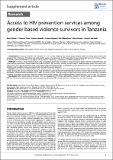| dc.contributor.author | Mboya, Beati | |
| dc.contributor.author | Temu, Florence | |
| dc.contributor.author | Awadhi, Bayoum | |
| dc.contributor.author | Ngware, Zubeda | |
| dc.contributor.author | Ndyetabura, Elly | |
| dc.contributor.author | Kiondo, Gloria | |
| dc.contributor.author | Maridadi, Janneth | |
| dc.date.accessioned | 2021-08-16T20:48:03Z | |
| dc.date.available | 2021-08-16T20:48:03Z | |
| dc.date.issued | 12/25/2012 | |
| dc.identifier.citation | Beati Mboya, Florence Temu, Bayoum Awadhi, Zubeda Ngware, Elly Ndyetabura, Gloria Kiondo, Janneth Maridadi. Access to HIV prevention services among gender based violence survivors in Tanzania. Pan Afr Med J. 2012;13(Supp 1):5 | en_US |
| dc.identifier.issn | 1937-8688 | |
| dc.identifier.uri | http://dspace.amref.org/handle/123456789/56 | |
| dc.description | Supplement sponsored by AMREF - African Medical and Research Foundation
© Beati Mboya et al. The Pan African Medical Journal - ISSN 1937-8688. This is an Open Access article distributed under the terms of the Creative Commons Attribution License (http://creativecommons.org/licenses/by/2.0), which permits unrestricted use, distribution, and reproduction in any medium, provided the original work is
properly cited. | en_US |
| dc.description.abstract | Introduction: Currently, Tanzania's HIV prevalence is 5.7%. Gender inequality and Gender Based Violence (GBV) are among factors fuelling the spread of HIV in Tanzania. This study was conducted to assess universal access to HIV prevention services among GBV survivors in Iringa and Dar-es-Salaam where HIV prevalence is as high as 14.7% and 9% respectively compared to a national average of 5.7%.
Methods: In 2010, a mixed methods study using triangulation model was conducted in Iringa and Dar-es-Salaam regions to represent rural and urban settings respectively. Questionnaires were administered to 283 randomly selected survivors and 37 health providers while 28 in-depth interviews and 16 focus group discussions were conducted among various stakeholders. Quantitative data was analyzed in SPSS by comparing descriptive statistics while qualitative data was analyzed using thematic framework approach.
Results: Counseling and testing was the most common type of HIV prevention services received by GBV survivors (29%). Obstacles for HIV prevention among GBV survivors included: stigma, male dominance culture and fear of marital separation. Bribery in service delivery points, lack of confidentiality, inadequate GBV knowledge among health providers, and fear of being involved in legal matters were mentioned to be additional obstacles to service accessibility by survivors. Reported consequences of GBV included: psychological problems, physical trauma, chronic illness, HIV infection.
Conclusion: GBV related stigma and cultural norms are obstacles to HIV services accessibility. Initiation of friendly health services, integration of GBV into HIV services and community based interventions addressing GBV related stigma and cultural norms are recommended. | en_US |
| dc.description.sponsorship | UNDP Tanzania | en_US |
| dc.language.iso | en | en_US |
| dc.publisher | Pan African Medical Journal | en_US |
| dc.subject | HIV | |
| dc.subject | People living with HIV | |
| dc.subject | Survivor | |
| dc.subject | Health services | |
| dc.subject | Access | |
| dc.subject | Gender-based violence | en_US |
| dc.title | Access to HIV Prevention Services among Gender-based Violence Survivors in Tanzania | en_US |
| dc.type | Article, Journal | en_US |

